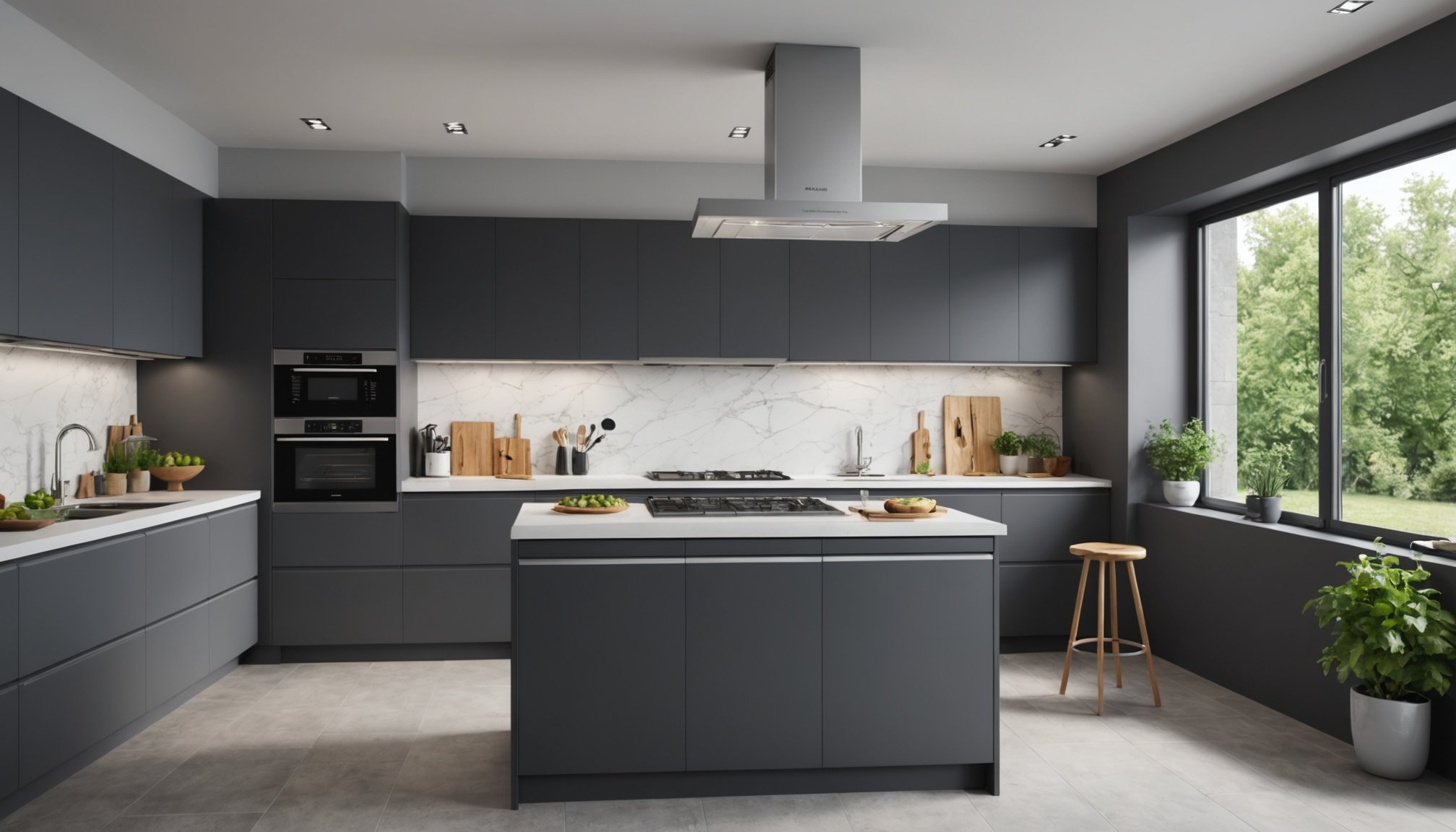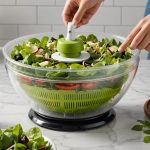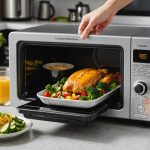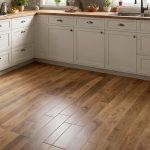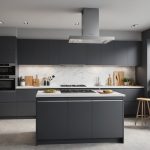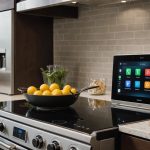As culinary spaces evolve, so does kitchen ventilation technology. Today's advancements enhance air quality, energy efficiency, and ease of use. Smart systems with innovative sensors monitor air quality, while sleek designs blend seamlessly into modern kitchens. Explore how these trends not only improve cooking environments but also contribute to healthier living. Stay informed to elevate your culinary experience and create a space where both cooking and comfort thrive.
Overview of Kitchen Ventilation Technology
Exploring the essentials of kitchen ventilation for improved air quality.
Topic to read : Discover the Most Recent Splashback Designs to Enhance Your Minimalist Kitchen Style
Importance of Kitchen Ventilation
Kitchen ventilation is crucial for maintaining air quality and ensuring a healthy environment. Without proper ventilation, cooking can release harmful pollutants, including carbon monoxide and nitrogen dioxide, into the air. These substances can lead to respiratory issues and other health problems. Effective kitchen ventilation helps in the removal of excess heat, moisture, and odors, making the kitchen a more comfortable space.
Historical Evolution of Kitchen Ventilation Systems
Over the years, kitchen ventilation systems have evolved significantly. Initially, simple windows or chimneys were used to vent smoke and odors. However, with technological advancements, sophisticated systems have been developed. Today’s systems are not only more efficient but also more environmentally friendly, incorporating features like energy recovery and smart controls.
Additional reading : Discover the Best User-Friendly Kitchen Interfaces for Your Smart Appliances
Key Components of Modern Kitchen Ventilation
Modern kitchen ventilation systems typically include several key components:
- Range hoods: Capture and remove airborne grease, combustion products, and steam.
- Ductwork: Channels the exhaust outside the home.
- Fans: Enhance airflow and improve efficiency.
Here's a quick comparison of modern ventilation options:
| Component | Function | Benefit |
|---|---|---|
| Range Hood | Captures pollutants | Improved air quality |
| Ductwork | Directs exhaust outside | Reduced indoor pollution |
| Fans | Increases airflow | Enhanced system efficiency |
Kitchen ventilation basics ensure that these components work together to maintain a safe and pleasant cooking environment.
Latest Innovations in Kitchen Ventilation
Exploring the forefront of innovative kitchen ventilation technology.
Smart Technology Integration
Modern kitchen ventilation systems are embracing smart technology to enhance user experience. These systems can now be controlled via smartphone apps, allowing users to adjust settings remotely. For example, smart range hoods can automatically adjust fan speed based on cooking activity. This integration not only improves convenience but also ensures optimal air quality at all times.
Energy-Efficient Designs
Innovative kitchen ventilation systems are increasingly focused on energy efficiency. New designs incorporate energy-saving motors and LED lighting, reducing power consumption without compromising performance. According to a recent study, energy-efficient ventilation can lower household energy bills by up to 20%. This shift towards sustainability is both economically and environmentally beneficial.
New Materials and Finishes
Aesthetics play a crucial role in the appeal of kitchen ventilation systems. The latest innovations include the use of sleek materials such as stainless steel and tempered glass, which blend seamlessly with modern kitchen designs. Additionally, customizable finishes allow homeowners to match their ventilation systems with existing kitchen decor, enhancing the overall look and feel.
- Smart technology: Remote control via apps
- Energy efficiency: Reduced energy consumption
- Aesthetic materials: Stainless steel, tempered glass
These advancements in innovative kitchen ventilation ensure that systems are not only functional but also stylish and efficient.
Types of Kitchen Ventilation Systems
Exploring diverse options for effective kitchen ventilation.
Range Hoods
Range hoods are a popular choice for many kitchens, known for their efficiency in capturing smoke and odors. They come in various styles, including wall-mounted, under-cabinet, and island hoods. Range hoods are effective in removing airborne grease and combustion products, making them essential for maintaining indoor air quality.
Pros:
- High efficiency in pollutant removal
- Variety of styles to suit different kitchen designs
Cons:
- Can be noisy at high speeds
- Installation may require professional assistance
Downdraft Ventilation
Downdraft ventilation systems are integrated into the cooktop, pulling smoke and steam downwards. This type of ventilation is ideal for kitchens with limited space or where overhead installation is challenging.
Pros:
- Space-saving design
- Discreet appearance
Cons:
- Less effective than range hoods for heavy cooking
- Limited to specific cooktop models
Whole House Ventilation
Whole house ventilation systems provide comprehensive air circulation throughout the home, not just the kitchen. These systems are beneficial for maintaining consistent air quality and temperature.
Pros:
- Consistent air quality
- Energy-efficient with proper design
Cons:
- Higher initial cost
- Complex installation process
| Type of System | Key Feature | Best For |
|---|---|---|
| Range Hoods | Removes airborne grease | Frequent cooking |
| Downdraft Ventilation | Integrated into cooktop | Limited space kitchens |
| Whole House Ventilation | Comprehensive air circulation | Whole-home air quality |
Features to Look for in Modern Ventilation Systems
Identifying essential key features in ventilation for enhanced kitchen performance.
Noise Levels and Sound Insulation Technology
Noise levels are a significant consideration in modern ventilation systems. High noise can be a nuisance, especially in open-plan kitchens. Sound insulation technology is a key feature that minimizes this issue, ensuring a quieter cooking environment. Look for systems with advanced insulation materials that reduce operational noise, making them more pleasant to use.
Airflow Rates and Efficiency
Airflow rates directly impact the efficiency of a ventilation system. Higher rates can effectively remove pollutants and odors, improving indoor air quality. When selecting a system, consider the cubic feet per minute (CFM) rating, which indicates the volume of air exchanged per minute. A higher CFM ensures better performance, especially in larger kitchens.
Filtration Systems and Maintenance Requirements
Effective filtration systems are crucial for trapping grease and particles. Modern ventilation systems often feature multi-layered filters that enhance air purification. Regular maintenance is essential to keep these systems efficient. Check for easy-to-clean filters, as this reduces upkeep time and ensures consistent performance.
- Key Features in Ventilation:
- Noise levels: Minimized by sound insulation
- Airflow rates: Higher CFM for better efficiency
- Filtration systems: Multi-layered for optimal air purification
These key features in ventilation ensure systems are efficient, quiet, and easy to maintain.
Installation Tips for Kitchen Ventilation
Ensuring a successful setup for optimal air quality.
Pre-installation Considerations
Before embarking on a kitchen ventilation installation, evaluate your kitchen’s layout and the type of system that best suits your needs. Measure the space where the ventilation system will be installed, ensuring there’s adequate clearance for components like ductwork and range hoods. Consider the existing electrical and plumbing setups to avoid costly modifications.
Professional vs DIY Installation Options
Deciding between a professional and a DIY approach is crucial. Professional installation offers the advantage of expertise, potentially saving time and avoiding errors. However, it comes at a higher cost. On the other hand, a DIY installation can be more economical but requires a thorough understanding of the system and adherence to safety standards.
- Professional Installation:
- Expertise and efficiency
- Higher cost
- DIY Installation:
- Cost-effective
- Requires technical know-how
Common Mistakes to Avoid During Installation
Avoiding common pitfalls can ensure a smooth kitchen ventilation installation. Ensure that the ductwork is properly sealed to prevent leaks and maintain efficiency. Avoid positioning vents too far from cooking surfaces, which can reduce effectiveness. Lastly, adhere to manufacturer guidelines to prevent voiding warranties.
“A successful installation begins with careful planning and consideration of all variables.”
Comparing Leading Kitchen Ventilation Brands
Exploring the landscape of kitchen ventilation brands and their offerings.
Overview of Top Brands
In the competitive world of kitchen ventilation brands, a few names consistently stand out due to their innovation and reliability. Bosch, Whirlpool, and Samsung are leaders, each bringing unique strengths to the market. Bosch is renowned for its precision engineering, offering systems with advanced filtration and energy-efficient designs. Whirlpool emphasizes user-friendly features and robust performance, while Samsung integrates smart technology to enhance user convenience.
Feature Comparison Across Different Brands
When comparing kitchen ventilation brands, key features such as noise levels, airflow efficiency, and smart capabilities are crucial. Bosch systems often feature superior noise insulation, ensuring a quieter kitchen environment. Whirlpool models excel in airflow efficiency, providing high CFM ratings for effective pollutant removal. Samsung, on the other hand, leads in smart technology, offering app-controlled systems for seamless operation.
Customer Reviews and Satisfaction Ratings
Customer feedback plays a vital role in assessing kitchen ventilation brands. Bosch frequently receives high marks for reliability and durability. Whirlpool is praised for its ease of use and effective performance, while Samsung garners attention for its innovative features. According to a recent survey, 85% of Bosch users reported high satisfaction, highlighting the brand's commitment to quality.
“Choosing the right brand can significantly enhance your kitchen experience.”
Case Studies: Successful Kitchen Ventilation Installations
Exploring real-life kitchen ventilation case studies for effective solutions.
Real-Life Examples of Effective Ventilation Solutions
In examining kitchen ventilation case studies, one notable example is the Smith family's renovation. They opted for a range hood with high airflow efficiency, achieving significant pollutant reduction. This choice improved indoor air quality, showcasing the importance of selecting the right system.
Analysis of Design Choices and Their Outcomes
Another compelling case involved the Johnsons, who integrated a downdraft ventilation system. This decision was driven by space constraints, yet it efficiently managed smoke and odors. Their experience highlights how thoughtful design choices can optimize limited kitchen space.
Key Design Choices:
- Range Hood: High airflow for pollutant removal
- Downdraft System: Space-saving efficiency
- Smart Controls: Enhanced user convenience
Lessons Learned from Case Studies
These kitchen ventilation case studies underscore the importance of tailoring solutions to specific needs. The Smiths benefited from high-performance features, while the Johnsons maximized space with innovative designs. The takeaway is clear: understanding your kitchen's unique requirements is essential for successful installations.
"Tailored solutions in kitchen ventilation can significantly enhance air quality and user satisfaction."
Impact of Kitchen Ventilation on Home Value
Enhancing property value through effective kitchen ventilation systems.
Enhancing Property Value
Kitchen ventilation systems play a significant role in boosting a home's value. Modern buyers are increasingly aware of the health benefits and comfort provided by effective ventilation systems. Homes equipped with advanced kitchen ventilation are often perceived as more desirable, leading to higher property appraisals.
Buyer Preferences
Recent trends indicate that buyers prioritize kitchen features that ensure safety and efficiency. According to a survey, 70% of potential homeowners consider a top-quality kitchen ventilation system a crucial factor in their purchasing decision. This preference underscores the importance of investing in reliable ventilation systems to meet market demands.
ROI on Upgrades
Investing in kitchen ventilation upgrades can yield a substantial return on investment (ROI). Homeowners who install energy-efficient and smart ventilation systems often recoup their costs through increased home value. A well-ventilated kitchen not only enhances daily living but also offers a compelling selling point.
- Key Benefits of Upgrades:
- Improved air quality
- Increased home value
- Higher buyer interest
“A well-designed kitchen ventilation system is a wise investment, offering both immediate comfort and long-term financial benefits.”
Expert Insights on Future Trends in Kitchen Ventilation
Exploring the future of kitchen ventilation through expert predictions.
Predictions for Technological Advancements
The future of kitchen ventilation is set to be transformed by cutting-edge technological advancements. Experts predict the integration of more artificial intelligence and machine learning, allowing systems to automatically adapt to cooking habits. This could mean ventilation systems that optimize airflow and filtration in real-time, enhancing efficiency and air quality.
Sustainable Practices in Kitchen Design
Sustainability is becoming a cornerstone in the future of kitchen ventilation. Designers are focusing on eco-friendly materials and energy-efficient technologies to reduce environmental impact. Solar-powered ventilation systems and recyclable components are expected to become more prevalent, aligning with the growing demand for green solutions.
- Sustainable Practices:
- Use of eco-friendly materials
- Integration of solar power
- Emphasis on energy efficiency
The Role of Consumer Preferences in Shaping Future Innovations
Consumer preferences are pivotal in shaping the future of kitchen ventilation. There is an increasing desire for systems that combine functionality with aesthetics. Consumers are also prioritizing smart features that offer convenience and control. As these preferences evolve, manufacturers are likely to focus on developing customizable and visually appealing ventilation solutions that meet diverse needs.
"The future of kitchen ventilation is driven by innovation and sustainability, reflecting changing consumer demands."

